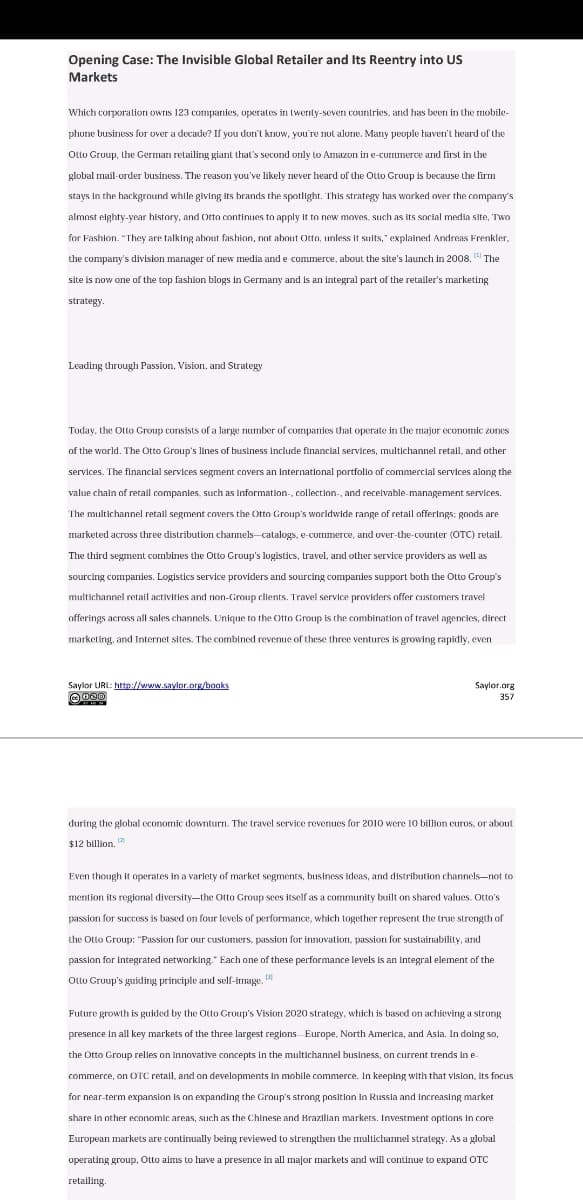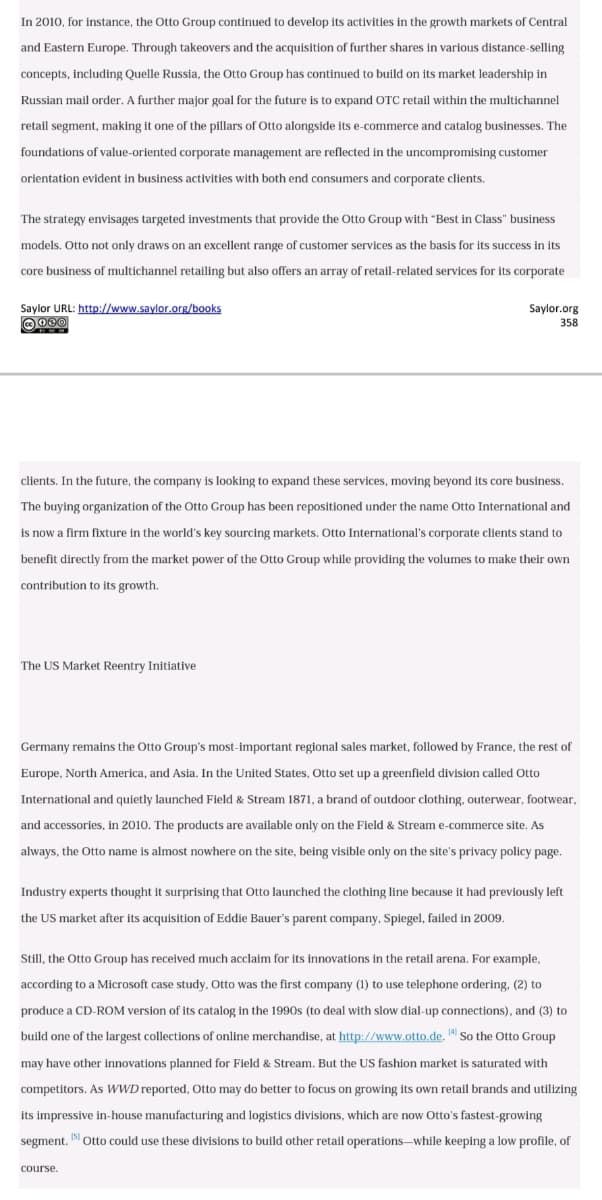4. After the Otto Group failed in its first effort to enter the US market with Spiegel, why would it try again? 5. How does this latest effort to enter the US market differ from its prior attempt?
4. After the Otto Group failed in its first effort to enter the US market with Spiegel, why would it try again? 5. How does this latest effort to enter the US market differ from its prior attempt?
Principles Of Marketing
17th Edition
ISBN:9780134492513
Author:Kotler, Philip, Armstrong, Gary (gary M.)
Publisher:Kotler, Philip, Armstrong, Gary (gary M.)
Chapter1: Marketing: Creating Customer Value And Engagement
Section: Chapter Questions
Problem 1.1DQ
Related questions
Question
4. After the Otto Group failed in its first effort to enter the US market with Spiegel, why would it try again?
5. How does this latest effort to enter the US market differ from its prior attempt?

Transcribed Image Text:Opening Case: The Invisible Global Retailer and Its Reentry into US
Markets
Which corporation owris 123 companies, operates in twenty-seven countries, and has been in the mobile-
phune business for over a decade? Il you dori't know, you're not alone. Marny people haveri't heard of the
Otto Gruup, the German retailing giant that's second only to Amazon in e-commerce and first in the
global mail-order business. The reason you've likely never heard of the Otto Group is because the firm
stays in the hackground while giving its brands the spotlight. This strategy has worked over the company's
almost eighty-year history, and Otto continues to apply it to new moves, such as its social media site, Two
for Fashion. "They are talking ahout fashion, nont about Otto, unless it suits," explained Andreas Frenkler,
the company's division manager of new media and e commerce, about the site's launch in 2008. The
site is now one of the top fashion blogs in Germany and is an integral part of the retailer's marketing
strategy.
Leading through Passion, Vision, and Strategy
Today, the Otto Group consists of a large number of companies that operate in the major economic zones
of the world. The Otto Group's lines of business include financlal services, multichannel retall, and other
services. The financial services segment covers an International portfollo of commercial services along the
value chain of retail companies, such as Information-, collection-, and receivable-management services.
The multichannel retail segment covers the Otto Group's worldwide range of retail offerings: goods are
Imarketed across three distributionn channels-catalogs, e-commerce, and over-the-counter (OTC) retail.
The third segment combines the Otto Group's logistics, travel, and other service providers as well as
sourcing companies. Logistics service providers and sourcing companies support both the Otto Group's
multichannel retail activities and non-Group clients. Travel service providers offer customers travel
offerings across all sales channels. Unique to the Otto Group is the combination of travel agencies, direct
marketing, and Internet sites. The combined revenue of these three ventures is growing rapidly, even
Saylor URL: http://www.saylor.org/baaks
Saylor.org
357
during the global economic downturn. The travel service revenues for 2010 were 10 billion euros, or about
$12 billion.
Even though it operates in a variety of market segments, business ideas, and distribution channels-not to
mention its regional diversity-the Otto Group sees itself as a community built on shared values. Otto's
passion for success is based on four levels of performance, which together represent the true strength of
the Otto Group: "Passion for our customers, passion for innovation, passion for sustairability, and
passion for integrated networking." Each one of these performance levels is an Integral element of the
Ollo Gruup's guikling principle and self-image.
Future growth is guided by the Otto Group's Vision 2020 strategy, which is based on achieving a strong
presence in all key markets of the three largest regions Europe, North America, and Asia. In dolng so,
the Otto Group relles on Innovative concepts in the multichannel business, on current trends In e-
commerce, on OTC retail, and on developments in mobile commerce. In keeping with that vision, its focus
for near-term expansion is on expanding the Group's strong position in Russia and increasing market
share in other economic areas, such as the Chinese and Brazilian markets. Investment options in core
European markets are continually being reviewed to strengthen the multichannel strategy. As a global
operating group, Otto aims to have a presence in all major markets and will continue to expand OTC
retailing.

Transcribed Image Text:In 2010, for instance, the Otto Group continued to develop its activities in the growth markets of Central
and Eastern Europe. Through takeovers and the acquisition of further shares in various distance-selling
concepts, including Quelle Russia, the Otto Group has continued to build on its market leadership in
Russian mail order. A further major goal for the future is to expand OTC retail within the multichannel
retail segment, making it one of the pillars of Otto alongside its e-commerce and catalog businesses. The
foundations of value-oriented corporate management are reflected in the uncompromising customer
orientation evident in business activities with both end consumers and corporate clients.
The strategy envisages targeted investments that provide the Otto Group with "Best in Class" business
models. Otto not only draws on an excellent range of customer services as the basis for its success in its
core business of multichannel retailing but also offers an array of retail-related services for its corporate
Saylor URL: http://www.saylor.org/books
O 000
Saylor.org
358
clients. In the future, the company is looking to expand these services, moving beyond its core business.
The buying organization of the Otto Group has been repositioned under the name Otto International and
is now a firm fixture in the world's key sourcing markets. Otto International's corporate clients stand to
benefit directly from the market power of the Otto Group while providing the volumes to make their own
contribution to its growth.
The US Market Reentry Initiative
Germany remains the Otto Group's most-important regional sales market, followed by France, the rest of
Europe, North America, and Asia. In the United States, Otto set up a greenfield division called Otto
International and quietly launched Field & Stream 1871, a brand of outdoor clothing, outerwear, footwear,
and accessories, in 2010. The products are available only on the Field & Stream e-commerce site. As
always, the Otto name is almost nowhere on the site, being visible only on the site's privacy policy page.
Industry experts thought it surprising that Otto launched the clothing line because it had previously left
the US market after its acquisition of Eddie Bauer's parent company, Spiegel, failed in 2009.
Still, the Otto Group has received much acclaim for its innovations in the retail arena. For example,
according to a Microsoft case study, Otto was the first company (1) to use telephone ordering, (2) to
produce a CD-ROM version of its catalog in the 1990s (to deal with slow dial-up connections), and (3) to
build one of the largest collections of online merchandise, at http://www.otto.de. 1 So the Otto Group
may have other innovations planned for Field & Stream. But the US fashion market is saturated with
competitors. As WWD reported, Otto may do better to focus on growing its own retail brands and utilizing
its impressive in-house manufacturing and logistics divisions, which are now Otto's fastest-growing
segment. Otto could use these divisions to build other retail operations-–while keeping a low profile, of
course.
Expert Solution
This question has been solved!
Explore an expertly crafted, step-by-step solution for a thorough understanding of key concepts.
This is a popular solution!
Trending now
This is a popular solution!
Step by step
Solved in 2 steps

Follow-up Questions
Read through expert solutions to related follow-up questions below.
Follow-up Question
please explain how Marcus Samuel broke Standard Oil's world dominance and established a thriving market in the East
Solution
Recommended textbooks for you

Principles Of Marketing
Marketing
ISBN:
9780134492513
Author:
Kotler, Philip, Armstrong, Gary (gary M.)
Publisher:
Pearson Higher Education,

Marketing
Marketing
ISBN:
9781259924040
Author:
Roger A. Kerin, Steven W. Hartley
Publisher:
McGraw-Hill Education

Foundations of Business (MindTap Course List)
Marketing
ISBN:
9781337386920
Author:
William M. Pride, Robert J. Hughes, Jack R. Kapoor
Publisher:
Cengage Learning

Principles Of Marketing
Marketing
ISBN:
9780134492513
Author:
Kotler, Philip, Armstrong, Gary (gary M.)
Publisher:
Pearson Higher Education,

Marketing
Marketing
ISBN:
9781259924040
Author:
Roger A. Kerin, Steven W. Hartley
Publisher:
McGraw-Hill Education

Foundations of Business (MindTap Course List)
Marketing
ISBN:
9781337386920
Author:
William M. Pride, Robert J. Hughes, Jack R. Kapoor
Publisher:
Cengage Learning

Marketing: An Introduction (13th Edition)
Marketing
ISBN:
9780134149530
Author:
Gary Armstrong, Philip Kotler
Publisher:
PEARSON


Contemporary Marketing
Marketing
ISBN:
9780357033777
Author:
Louis E. Boone, David L. Kurtz
Publisher:
Cengage Learning